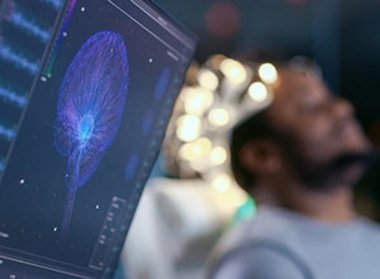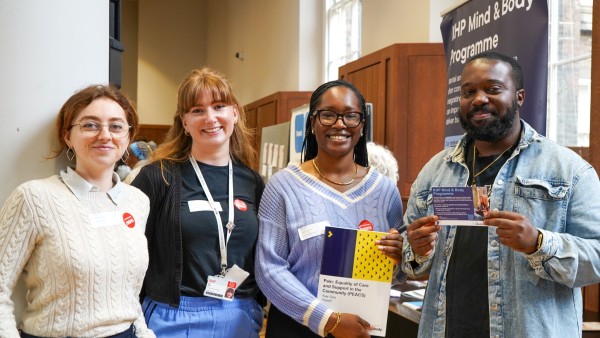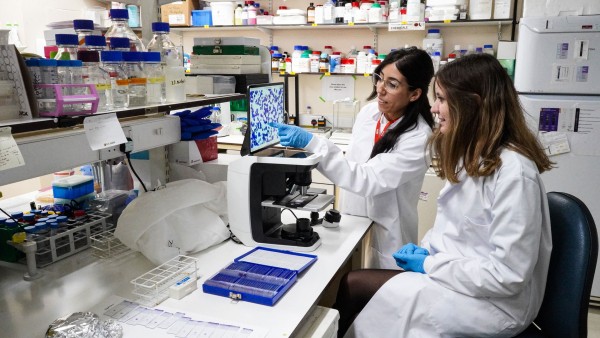20 October 2021
Imagine having a headache that couldn’t be cured. Hear about the new treatment techniques which could help overcome this.
The lead for the King’s Health Partners spinal cerebrospinal fluid (CSF) leak service talks to us about how their team have implemented new diagnosis and treatment techniques for patients with a specific type of debilitating headache.
Most headaches are temporary and can be cured, but for some people with a rare condition called spontaneous intracranial hypotension this can be a daily occurrence, caused by a small leak of fluid from the spine. As the leak is small, they are very difficult to accurately diagnose and require a specific neuroradiological technique called myelography to pinpoint where treatment should be directed. As a result, this condition isn’t widely known about, and often patients can be misdiagnosed or unable to access specialist curative treatment.
We spoke with Dr Lal Carlton Jones who leads the spinal CSF leak service at King’s Health Partners about the developments that have been happening in this area internationally, as well as being the first organised multidisciplinary team in the UK to offer a cure for patients with this condition.
What is your role within King’s Health Partners Neurosciences?
I'm a consultant neuroradiologist and I work across King’s Health Partners at both Guy's and St Thomas’ and King's College Hospital NHS Foundation Trusts and I'm the lead for the spinal CSF leak service, or spontaneous intracranial hypotension, service.
Spontaneous intracranial hypotension is an under recognised and under diagnosed cause of debilitating headaches which occur as a result of a leak of cerebrospinal fluid from the spine. In the past, the diagnosis, investigation, and management of these patients across the UK has been quite variable with many patients being misdiagnosed or eventually only getting their diagnosis after a long delay. Many have even sought treatment abroad, often at centres in the US that are specialists in the diagnosis and treatment of these patients.
Just over two years ago I was supported by Prof Peter Goadsby and King’s Health Partners to visit Cedars Sinai Medical Centre in Los Angeles, which is the world leading hospital for the management of these conditions, to learn some of the newer techniques in this area. Since then, I've kept in regular contact with the teams at Cedars Sinai, and other centres in America, so that we can keep up to date with the different techniques for diagnosing and managing these patients at King's Health Partners.
In my role I’m working with a team of neurologists and neurosurgeons across King’s Health Partners to standardise the investigation and management pathways for these patients. Neuroradiologists play a critical role in each of these aspects, both to help make earlier diagnoses and locate exactly where in the spine patients are leaking CSF from, and to plan targeted treatment in those cases where it’s necessary.
Please tell us about the spinal CSF leak service.
In our service the neurologists take charge of the primary care of these patients and the first thing we do is make a diagnosis, both a clinical diagnosis and the original imaging diagnosis, so that we know if it’s a spinal CSF leak or not. The classic teaching on CSF leaks is that a patient will present with a specific type of headache. However, we now know from the work that’s been pioneered in the US that this isn’t always typical and that sometimes peoples’ symptoms are quite wide-ranging, so there can often be a misdiagnosis as a migraine or another type of headache, if not considered by a specialist team.
For instance, one of the first cases at King's College Hospital NHS Foundation Trust was a young patient who presented with very rapidly progressive dementia that went into a comatose state. Thankfully as we were able to investigate and consider the imaging closely, we could diagnose the CSF leak and provide a curative treatment. I think the condition is probably far more common in the UK than we think it is, partly as it’s hard to diagnose and partly because there isn’t a lot of awareness at a primary and secondary care level yet.
Once we have made the diagnosis, we then move onto the primary management of the condition, which is often performing an epidural blood patch, usually undertaken by myself and sometimes with the help of an anaesthetist as well.
Many patients will respond well to this intervention, but for the ones that don’t we will often then need to move on to a more advanced imaging technique called myelography to find where these very small CSF leak points are exactly. Once we’ve located the site of the spinal leak, we can then plan a more targeted treatment which is initially via a fibrin glue patch, a biological adhesive that I inject under imaging guidance to directly seal the leak. When we started doing this, we were the first in the UK to register the procedure with National Institute for Health and Care Excellence (NICE), it having only previously been performed in the US centres. This meant we first had to get the procedure approved by the Trust’s new procedures committee before attempting. Having done this successfully with our first patient, we now do this quite frequently for many patients where we have located a small leak site and in about half of all cases this provides a cure for patients.
Finally, for those patients who don’t respond, we would then bring in our neurosurgical colleagues who are part of the team to perform open spinal surgery on the site of the leak. So, there are points along every part of the management pathway where we need neurologists and neurosurgeons on board as part of the decision making. To help this, we are working as part of a CSF disorders multidisciplinary team, meaning we all meet once a month to discuss cases and plan treatments, so it’s very much a team approach to reach the right decision for a patient.
Because this condition has gained recognition over the last few years as these advanced techniques in myelography and newer treatments have come into practice, it means that more people are getting interested in recognising this condition and that patients hopefully don’t have to travel abroad for treatment. As a result, I’m now part of a working group, led by the CSF Leak Association charity, of neuroradiologists, neurologists, neurosurgeons and anaesthetists looking to develop the first UK guidelines for the diagnosis, investigation and management of this condition. It’s really great that we have King’s Health Partners representation as part of that panel particularly as we have been pioneers of much of this treatment in the UK.
How is the group seeking to improve outcomes for patients with spontaneous intracranial hypotension?
Of course, a lot of people can’t afford to go abroad for treatment, so what can often happen for these patients is that they would get their diagnosis, they would often then have a couple of blood patches and they would not be cured because there is still a CSF leak somewhere. These patients would then get left in no man's land in a sense if they aren’t able to access these new treatments.
We had a recent patient who was a very highly achieving individual but who had been suffering for years and eventually had to stop working. Their condition hadn’t been fully recognised and they were initially told their imaging was normal. For a lot of patients their imaging can be negative when they first present and, for reasons we don’t fully understand yet, initially abnormal imaging can later normalise even though there is still a leak present, which can make diagnosis very challenging.
We knew when we reviewed this patient’s initial imaging that there was an abnormality, but the signs were subtle, so I went on to do a myelogram and found that there was a CSF-venous fistula which is where CSF is leaking into a tiny abnormal vein. These have only really become recognised in the last few years, essentially because they are incredibly small but can cause huge problems, and you need these advanced techniques such as myelography to be able to find them. To treat the patient, I was then able to do a fibrin glue patch exactly at the right point to stop the leak. A week later the patient called their neurologist and said that for the first time in four years they had been headache free and hadn’t had to lie down in bed all day.
This person had been hugely impacted by having this condition, but by being able to receive this minimally invasive treatment it has completely changed their life. So, one of the benefits is that now within the neurosciences department people know that I have an interest in this area and there is a team that can do things to help people. What’s great is that when people are identified as possibly having the condition, we can then put them on our pathway immediately and get things organised so that they are worked up for the correct procedure as quickly as possible.
And then the other thing I would say that is beneficial for improving outcomes is the network I’m part of with the other people who are doing this work worldwide, particularly the leading centres in the US. We discuss our cases and help each other because this work can be difficult. I think without getting that kind of support from colleagues at places like Cedars Sinai and Duke Medical Center we wouldn’t have been able to make so much progress here too. Additionally, we’re all known to each other in that community, so if patients are stuck they will often contact the CSF Leak Association and can be put in touch with someone local to them, and as King’s Health Partners has established a reputation for delivering this care we often have a lot of patients approaching us directly this way to access care.
What do you think has had the most positive impact on patients this past year?
When patients become known to me or our team they now get put onto our clear and structured pathway. This means patients know what is going to happen to them once they have their diagnosis. Implementing that pathway as part of our CSF disorders multi-disciplinary team has allowed that to happen.
We’re also very grateful for the new procedures committee who have allowed me to perform these new techniques based on the evidence in the literature, as there wasn’t much initial data. This means we’re now able to cure many patients through these minimally invasive techniques, where previously this was seen as an incurable condition.
What will your team be focusing on in the coming years?
Firstly, spinal CSF leaks is an area where there has been a continual development and refinement of methods for diagnosing and treating patients. I would say that a lot has changed in the last year alone, for instance I am currently refining a new minimally invasive investigation technique that is better for patients which we’re looking to publish soon. So, I’m working to ensure that King’s Health Partners is at the forefront of applying these latest techniques for the benefit of patients.
What we’ll be looking at more in the future is those patients whose symptoms suggest they have the condition, even when their imaging looks normal but they still have a CSF leak. Identifying these patients remains a great challenge which many groups around the world are working on. We want to ensure we don’t lose sight of these patients in the community, or out to other centres that may misdiagnose them. We know that the evidence says that the sooner we identify these patients the easier it is to identify where the leak is coming from and offer curative treatment.
What does your team value most about being part of King’s Health Partners?
I really value working as part of a multidisciplinary team of neurosurgeons and neurologists across our sites because it gives us a real diversity in our clinical, diagnostic and management approach which can only benefit patients. By having a collective team approach to things rather than a single operator’s approach we can make sure we always offer the best options to patients.
Liked this article? Find out more about the important work King’s Health Partners Neurosciences is doing to drive improved holistic outcomes for patients living with a wide range of neurological conditions.





